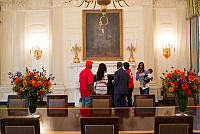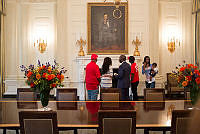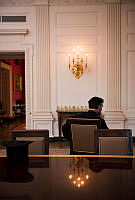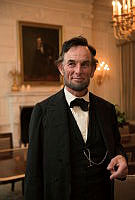Rubenstein Center Scholarship
Khrushchev Goes to Washington
In September 1959, President Dwight D. Eisenhower invited Soviet Premier Nikita Khrushchev to the United States for an official State Visit. Eisenhower’s invitation marked a historic moment: the first time a Soviet head of state received an invitation to the White House. This event marked an opportunity for each leader to learn about their counterpart while sharing their country’s immediate concerns, which included military de-escalation, nuclear arms, and trade.
The Bolshevik Revolution in 1917 and the United States Allied Intervention in the Russian Civil War in 1918 marked a period of growing strain between the two nations. Tensions between the United States and Soviet Union further developed in the years leading up to World War II.1 Despite this strained relationship, the United States ultimately allied with the Soviet Union and Great Britain against Nazi Germany, Japan, and Italy during the war.2 While President Franklin D. Roosevelt and British Prime Minister Winston Churchill envisioned a post-war world dedicated to democracy and self-government,3 Soviet leader Joseph Stalin created a geopolitical sphere of influence by supporting Communist movements abroad, as well as repressing their opponents with violence and authoritarianism. On April 12, 1945, less than three months into his fourth term, President Roosevelt died from cerebral hemorrhage.4 His successor, President Harry S. Truman, oversaw the final six months of American involvement in World War II. One of his most consequential acts during this time was his decision to use atomic weapons against Japan. As the United States was the only country in the world with the bomb, leaders struggled over the scientific, military, and ethical implications of this decision. World War II’s conclusion gave way to the Cold War, a period of cultural, technological, educational, economic, political, and military rivalry between the United States and the Soviet Union as each nation attempted to establish itself as the new world leader. The Soviet Union also accelerated its development of nuclear weapons during and after the war, further fueling the ongoing conflict. Premier Khrushchev’s official visit to the United States illustrated this rivalry.
When President Dwight D. Eisenhower took office on January 20, 1953, he prepared to confront the Cold War and Joseph Stalin, the Soviet dictator who had ruled for nearly three decades, head-on. Because of his successful career as a five-star general in the United States Army, President Eisenhower was well-versed in military action and diplomacy.5 However, Stalin’s death on March 5, 1953, changed the calculus of the American and Soviet relationship. Nikita Khrushchev quickly claimed power and advocated a position of "peaceful coexistence," attempting to move past the Stalinist view that war between capitalist and communist nations was inevitable.6 However, Eisenhower found Khrushchev's "peaceful coexistence" suspicious, believing it might let American officials’ “guard[s] down prematurely.”7
As part of the Cold War, education, technology, and culture became battlegrounds between the United States and the Soviet Union. On October 4, 1957, the Soviet Union took the lead, launching Sputnik 1, the first artificial satellite to enter orbit in the atmosphere.8 Particularly concerning to Americans, Sputnik passed over the United States multiple times a day, sparking widespread anxiety. In response, President Eisenhower advocated for increasing federal funding to support science, technology, language, scholarship, and graduate fellowship funding to meet these new demands.9 While the education plan was costly, at around $1 billion over four years, historian William I. Hitchcock argues that Congress supported the plan because of their concerns related to Sputnik.10 On January 31, 1958, the United States officially entered the space race, launching the Explorer I satellite into orbit. On July 29, 1958, President Eisenhower signed the National Aeronautics and Space Act into law, establishing the National Aeronautics and Space Administration (NASA). NASA was specifically created to facilitate civilian space exploration, indicating a commitment to peaceful scientific discovery.11 Despite this nod toward science for the sake of discovery and knowledge, the space race was also another manifestation of the Cold War.12
On July 12, 1959, President Eisenhower sent U.S. Deputy Undersecretary of State Robert Murphy to speak with Deputy Prime Minister Frol R. Kozlov of the Soviet Union. At this private meeting, Murphy asked Kozlov to carry a sealed letter to Premier Khrushchev.13 Although the original is no longer available, a draft of the president's letter stated, "…it has seemed to me that it would be mutually profitable for us to have an informal exchange of views about problems which interest both of us.”14 President Eisenhower extended an invitation for Premier Khrushchev to visit the White House.
Once Premier Khrushchev received the invitation, he and President Eisenhower wrote to each other outlining the logistics and intentions of the visit. In one letter, Khrushchev stated his goal for the visit was “to find a common language and common understanding of the problems we are to resolve.”15 While these negotiations continued, Vice President Richard Nixon visited the Soviet Union from July 23 through August 2, 1959, to open the American National Exhibition in Moscow’s Sokolniki Park along with the president’s brother and advisor, Dr. Milton Eisenhower.16 Famously on this trip, the vice president and Soviet premier engaged in a heated debate over the technology displayed in the American National Exhibition, with Nixon and Khrushchev arguing over their nations' respective technological feats in television, rocketry, and construction.17 Although an unofficial visit, Nixon's trip can be viewed as the precursor to Khrushchev's visit to the United States. Vice President Nixon and Dr. Eisenhower carefully collected information to better prepare President Eisenhower for Khrushchev’s upcoming visit.18 On August 1, 1959, after meeting with Nixon, Khrushchev formally accepted President Eisenhower’s invitation.

Premier Nikita Khrushchev and Vice President Nixon at the kitchen display in Moscow, July 24, 1959.
Richard M. Nixon Presidential Library and Museum/NARAWhile Vice President Nixon was not typically involved in Soviet negotiations, on this visit he played a key role in highlighting his and President Eisenhower’s goal of de-escalation to Premier Khrushchev and his fellow citizens.19 When Vice President Nixon and Dr. Eisenhower returned from the Soviet Union, they met with President Eisenhower and six staffers in the Oval Office for over an hour.20 In this meeting, Nixon advised that the only solution to the ongoing tensions was to open the door to Soviet-American contact, stating that “people [in the Soviet Union] are hungry for news of the outside world.”21
On September 15, 1959, Nikita Khrushchev landed at Andrews Air Force Base at 12:21 p.m. He was accompanied by his wife, Nina Petrovna Khrushcheva, his daughters Julia Nikitichna and Rada Nikitichna Adzhubei, his son Sergei Nikitich Khrushchev, and his son-in-law Alexei Ivanovich Adzhubei. That morning, President Eisenhower met with his Chief of Staff Wilton B. Persons and White House Press Secretary James Hagerty in the Oval Office for nearly two hours, finalizing preparations for the Soviet leader’s visit.22
Upon their arrival, Eisenhower delivered a welcome speech at Andrews Air Force Base. He emphasized that the goal of the State Visit was for Premier Khrushchev to gain a better understanding of the United States' system of government, its foundational principles, and its citizens. He contrasted American democracy with the Communist Party of the Soviet Union stating, "although they have built and maintain strong security forces, it is clear that because our people do want peace and because they are the decisive influence in basic actions of our Government, aggression by this Nation is an impossibility.”23
President Eisenhower and Premier Khrushchev then followed many of the common proceedings of a State Visit. First, they inspected the troops, walking along rows of uniformed men standing at attention.24 After this, the president, premier, and his wife Nina Petrovna Khrushcheva rode together in a car to Blair House on Lafayette Square, where the Khrushchevs stayed during their visit. In response to overcrowding at the White House by diplomats, Joint Chiefs of Staff, and politicians during World War II, the State Department purchased Blair House in 1942. Since then, the Blair House has served as the residence for visiting diplomats, their families, and the president-elect the night before the Inauguration Day ceremonies.25
Later that day, the president and premier met in the Oval Office. Khrushchev gave President Eisenhower a wooden box containing a model of a metallic sphere made up of pentagonal pennants. The actual sphere was placed in the Luna II spacecraft and filled with an explosive charge designed to burst once it reached space, thus depositing the pennants, inscribed with "Union of the Soviet Socialist Republics" on the moon.26 This gift was especially notable given the ongoing tensions of the space race and the Cold War. Only two days before the premier arrived in Washington, the Soviet Union successfully landed the unmanned Luna II spacecraft on the moon.27 Khrushchev’s gift to President Eisenhower touted Soviet achievements in technology and science, as well as their early lead in the race to the moon.

Model of the Soviet Pennant sphere that went to the moon on the Luna II.
Wikimedia CommonsDuring the first day’s meeting, President Eisenhower urged Premier Khrushchev to advocate peace between the United States and the Soviet Union. In a memorandum of this private conversation, Eisenhower said, "Mr. Khrushchev could do a great deal for peace by exercising the power he possesses in that direction.”28 In response, Khrushchev said he shared Eisenhower's goal, although it could not be realized by only one nation putting forth effort. This conversation illustrates the language used in these talks, where both leaders wanted peace but on their own terms. During the planning stages of the visit, President Eisenhower, in a gesture similar to Khrushchev’s gift, displayed his own technological power and invited the premier on a helicopter tour of Washington, D.C. Khrushchev initially declined the invitation. In his autobiography Waging Peace, President Eisenhower wrote, “while riding with [Khrushchev] from the airport that morning I deliberately expressed my regret that he could not join me on this kind of sightseeing for I had found them convenient and always interesting. ‘Oh,’ he replied, ‘If you are to be in the same helicopter, of course I will go!’”29 This moment, discussing relatively relaxed sightseeing, reflects the mistrust between the two leaders.

This photograph of President Dwight D. Eisenhower and Soviet Premier Nikita Sergeevich Khrushchev was taken on September 15, 1959. In the photograph, President Eisenhower and Khrushchev can be seen disembarking a presidential helicopter on the South Lawn of the White House Grounds following an impromptu aerial tour of Washington, D.C. During the helicopter tour, the two flew over the National Mall, the monuments, and the local suburbs of Washington, D.C. Khrushchev's 12 day visit to the United States included visits to New York City, Hyde Park to pay respects to former First Lady Eleanor Roosevelt, Los Angeles, San Francisco, corn farms in Iowa, Pittsburgh, Camp David, and Eisenhowers farm at Gettysburg, Pennsylvania.
Dwight D. Eisenhower Presidential Library and Museum/NARALater that evening, President Eisenhower and First Lady Mamie Eisenhower hosted a State Dinner for Nikita and Nina Khrushchev with one hundred invited guests in attendance. The menu featured American recipes including crab louis, coleslaw, Boston brown bread, roast turkey, cornbread dressing, and lady fingers coated in a lime glacé.30 The festivities concluded with Fred Waring and his Pennsylvanians performing American songs.31 This first evening of entertainment highlighted the American culture, food, music, and way of life that President Eisenhower wanted to portray to his Soviet visitors.

Nina Khrushchev, First Lady Mamie Eisenhower, President Dwight D. Eisenhower, and Premier Nikita Khrushchev at the White House
Wikimedia CommonsThe next night, Mrs. Khrushcheva hosted a formal dinner at the Soviet Embassy. President Eisenhower, First Lady Mamie Eisenhower, Vice President Nixon, and Second Lady Pat Nixon all attended the dinner. The meal highlighted Eastern European cuisine including stuffed partridge, borscht, Caucasian wines, and fresh macaroons.32 That evening, the winner of the Soviet-sponsored Tchaikovsky International Music Competition, American pianist Van Cliburn, performed for the guests at the dinner.33
In addition to visiting the capital city, Khrushchev and his family toured the country during their thirteen-day visit. Henry Cabot Lodge Jr., ambassador to the United Nations, acted as the Soviet contingent’s tour guide. On their second day, they visited the United States Department of Agriculture in Beltsville, Maryland, and took a sightseeing tour of Washington D.C. The premier remarked that his favorite part of the tour was the Lincoln Memorial as he was a "fighter for freedom.”34
Upon Khrushchev’s return, on September 25, he and Eisenhower spent two days at Camp David in Thurmont, Maryland. Renamed for his grandson David, the president enjoyed the tranquility and peacefulness of Camp David. Khrushchev in comparison was somewhat suspicious of the site because of its remoteness.35
Serious preparation went into the Soviet premier’s visit to Camp David. An operations plan included every detail from sleeping arrangements, transportation, medical care in case of emergency, security, music, dinner menus, and even the movies available. Despite Camp David’s seclusion, like any place the president travels, there are still high levels of security involved. Everyone at Camp David aside from the “four top principals of the conference and support person residing in Aspen lodge,” always wore Camp David security passes.36 President Eisenhower, Secretary of State Christian Herter, Premier Nikita Khrushchev, and Soviet Minister of Foreign Affairs Andrei Gromyko were all assigned to stay in the four bedrooms of Aspen Lodge. Other diplomats, aides, secretaries, Secret Service agents, and military personnel were assigned rooms throughout the camp, creating a high security environment in the middle of the secluded woods.
Dinner on September 26 featured several American classics: strip steak, broccoli in hollandaise sauce, buttered bread, an assorted green salad, and vanilla ice cream topped with maple syrup and mixed nuts. The movies available also reflected American popular culture at the time, offering several westerns and musicals like Gunfight at the OK Corral and Seven Brides for Seven Brothers. The music selected for meals at Camp David sparked a conversation between Secretary of State Christian Herter and John A. Calhoun, Director of the Executive Secretariat. Calhoun commented that the initial list of Russian folk songs proposed were “rather undistinguished,” and two of which were potentially controversial.37 Instead, he suggested rather than having an orchestra play the initial compilation, they get a pianist and soloist to sing a Soviet published selection of songs.
At Camp David, Premier Khrushchev and President Eisenhower toured the grounds. While visiting the bowling alley located in Hickory Lodge, Eisenhower and Khrushchev watched Yeoman 2nd Class John Halferty of Fennimore, Wisconsin, bowl. Khrushchev took interest in the bowling alley machinery, which included the automatic pin setting machine. After Halferty rolled a 218 game, President Eisenhower and Premier Khrushchev congratulated him and signed his scorecard.38 In his autobiography, President Eisenhower explains,
“during the sessions the Chairman and I seized several opportunities for strictly private conversations, some at Camp David other while sightseeing around the countryside. Because my purpose in these man-to-man talks was to learn more about his intentions, objectives, and personal characteristics, we used a single interpreter only—his own.”39
On one of these excursions, the two leaders traveled by helicopter to Eisenhower’s farm in Gettysburg, Pennsylvania. While in Gettysburg, they toured the Eisenhower’s farm, the nearby Fiester Farm, and went skeet shooting at the range.40 When they returned to Eisenhower’s Gettysburg home, he met the president’s daughter-in-law, Barbara Jean Thompson Eisenhower, and the president’s grandchildren.41 Premier Khrushchev was amiable and spoke at length with the Eisenhower grandchildren asking their names and telling the family about his own grandchildren.42 Khrushchev also showed so much interest in the cattle that President Eisenhower was raising at the Gettysburg farm that the president sent a young Black Angus bull to Moscow as a gift. Premier Khrushchev reciprocated the gift, sending birch trees to President Eisenhower for the farm.43 The two leaders returned to Camp David at 6:00 p.m. Saturday evening.

President Dwight D. Eisenhower and Chairman Nikita Khrushchev at Camp David.
Dwight D. Eisenhower Presidential Library, Museum & Boyhood HomeOn Sunday afternoon, President Eisenhower and Premier Khrushchev concluded the two days of meetings. Although the conversations at Camp David did not provide immediate resolutions to Cold War Era tensions, it did mark a step forward in U.S.-Soviet relations. The conversations marked a thaw and moment of diplomatic progress in the post atomic world. Most importantly, it supported an environment of verbal debate rather than nuclear threat.44 After the talks at Camp David, Premier Khrushchev and President Eisenhower returned to Washington. That same day, Khrushchev and his family departed Blair House for the Soviet Union. At this point in time, conversations relating to President Eisenhower’s reciprocal visit progressed, although they would not occur in 1959.

President Eisenhower greeting Chairman Khrushchev at Blair House before Khrushchev's departure.
Library of CongressInstead, this progress regressed the following spring. On May 1, 1960, Soviet military forces shot down a United States U-2 reconnaissance plane flying over Soviet airspace. The United States had used U-2s for several years to gather intelligence on Soviet missile capabilities. Although Eisenhower limited U-2 flights during 1959 due to concerns over Berlin, Khrushchev’s visit, and the thawed relationship after Camp David, the intelligence community insisted on collecting more information, and President Eisenhower relented. Further complicating the matter, both President Eisenhower and Premier Khrushchev met in Paris on May 16 for a summit meeting between the United States, Soviet Union, Great Britain, and France. Although the summit was planned to discuss disarmament, nuclear weapons testing, and Berlin, it was overshadowed by the U-2 incident. Ultimately, it led to further mistrust, heightened tensions, and the cancellation of President Eisenhower's reciprocal visit to Moscow.45























